[ad_1]
Picture this: You’ve built a business you love—and a site you’re proud of to go along with it. Your site acts as a resource for your current customers and attracts plenty of curious new faces from across the internet. You’ve even earned top spots in some of your most important keywords!
Then, one day, everything changes.
Suddenly, you find that your average position has dipped. Traffic has plummeted. Your biggest competitor now owns the top spot.
It probably feels something like this:
What the heck happened?!
Short answer: A Google algorithm update. It rocked through the SERPs like an earthquake. You weren’t prepared, and like many SEOs, you now have a big task ahead of you.
How do you recover your traffic and Google rankings after such a big shake-up?
Below, we’ll take you through the recovery process step by step so you can update your content quickly, easily, and strategically.
What Do Google Updates Do?
Google updates involve changes to the algorithms that guide the search engine’s rankings, designed to provide better, more relevant information for users. They do this by changing things like:
- How Google interprets user intent
- How information is presented on the screen (e.g., in advanced search features)
- How site content is analyzed and delivered to users
Depending on the scale and content of the update, this can have a major effect on your site’s organic performance. Or, depending on the nature of the update and how that relates to your site content, it might have no impact at all.
How Often Does Google Update?
Google makes minor tweaks to its algorithms every day. The exact number of daily updates, however, is unknown. Back in 2017, Google’s Gary Illyes said that it had “3 updates a day [on] average.” As of 2022, Search Engine Land estimated that Google changed about 12 times per day.
These updates are often technical in nature and may be unique to a certain region, type of website, or language. Most of the time, you may not even notice them.
However, several times a year, Google releases a broad core update that focuses on improving Google’s services overall, and as a result causes big fluctuations in search rankings.
How Do You Stay on Top of Google Algorithm Changes?
In some cases, Google will alert you about their updates via their official channels, such as Twitter or the Search Central blog. In other cases, they won’t confirm it at all.
If a confirmed update is on a smaller scale (for example, addressing a specific technical issue), then Google might also provide guidance on how to respond to it.
However, the more complex the update is, the less likely Google is to offer specific advice beyond its existing documentation.
These large-scale updates are also called “broad core algorithm updates.” They often focus on high-priority issues like content quality or search intent, and they tend to have the biggest impact on your performance.
If Google doesn’t announce that an update happened, then you’ll have to pay attention to your site data, track your competitors’ performance, and listen to what the SEO community at large is saying in order to find out about it.
For example, some followers of Search Engine Journal may have learned about October 2022’s anti-spam update from this tweet:
In other words, listen to peers and experts in the office, on Twitter, and even LinkedIn, because they may provide valuable insights.
How to Recover from a Google Algorithm Update in 3 Steps
What exactly you should do to recover from a Google update will vary; it depends on your site and the nature of the update in question.
For example, let’s say you run a personal finance blog and offer online courses aimed at helping people learn how to budget, invest, and other related skills. If Google releases an update about product listings and you don’t have any of those, you probably won’t have to do much.
On the other hand, if you run an ecommerce business and Google releases that same update, you might have an enormous task ahead of you.
Luckily, any site can recover—or even improve—by following a basic, three-step process:
- Research the update
- Create an action plan
- Strategically update your content
We’ll go through each step in detail below.
Step 1. Research
Before you can start making updates to your site, you need to confirm a few things:
- Was there actually an update, or is there another explanation?
- If there was a Google update, what was its goal?
- Which content on your site was affected?
Let’s tackle the first question.
Was There Actually an Update?
If you didn’t know about the update in advance, chances are you either found out because your site performance suddenly and dramatically changed, or because you heard about it from someone else.
Either way, take some time to confirm before moving forward.
How?
By comparing your performance to more general trends. After all, if there was a legitimate update, it’s probably going to impact a lot more than just your site. Start by checking an objective source like the free Semrush Sensor tool, which tracks SERP volatility:
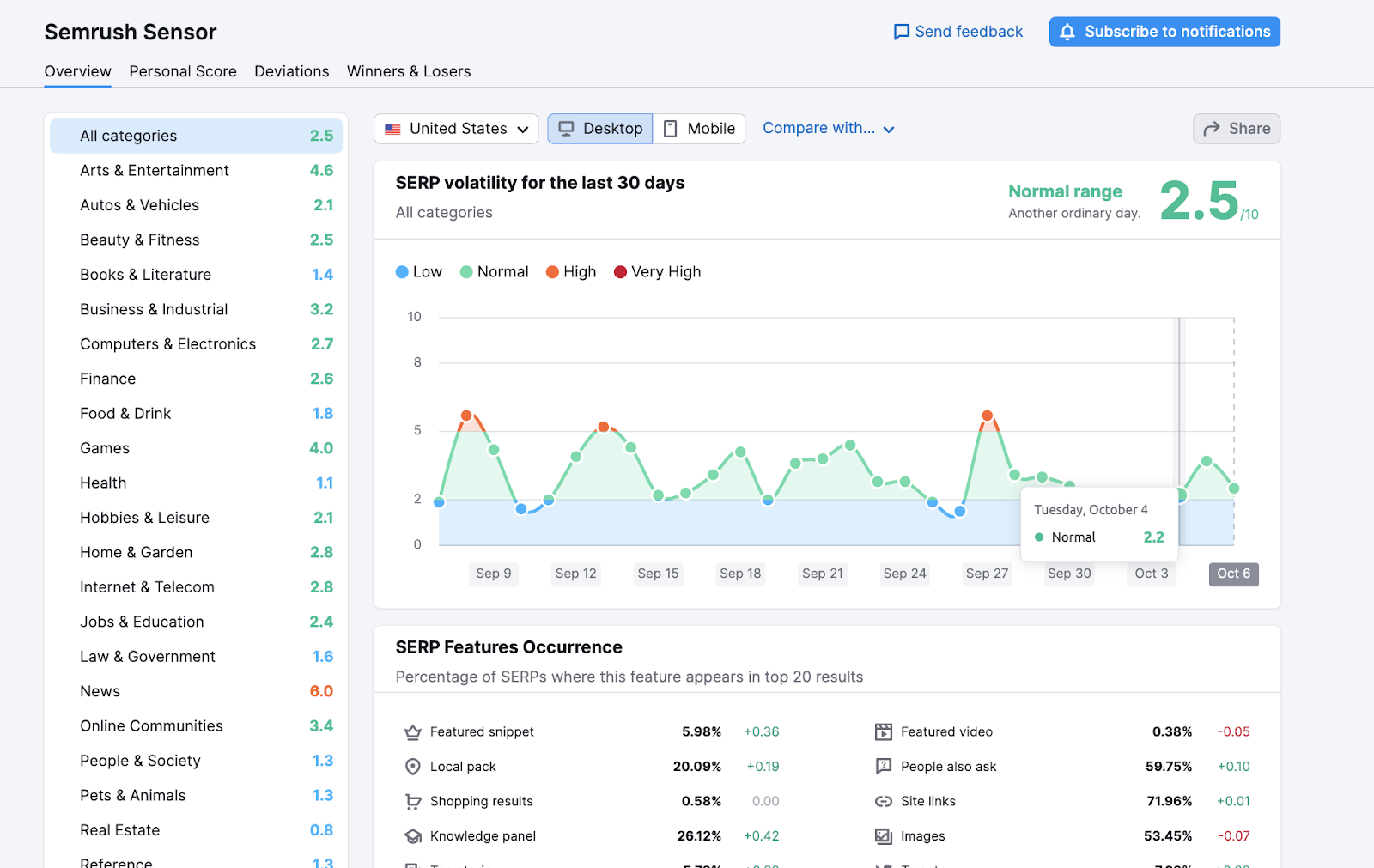
The volatility score tells you how many changes there have been when compared against a typical time frame. In the above example, the number of changes in search engine results fell well within the normal range for a typical day. On the other hand, if the score were a lot higher than usual, that could indicate an update.
Pro tip: Keep in mind that the “normal” volatility score is relative to the category you’re viewing. For example, because news content changes every day, it’s normal for that category to have a higher score.
Also filter by device type, region, or category to check for a more narrow update that only impacts certain sites. If you don’t see any signs of one, but your rankings changed significantly out of nowhere, then you might need to search for other causes.
However, if all signs point to yes, then proceed to the next question:
What Was the Goal of the Update?
Despite what it may seem, the goal of any content creator, SEO, or site owner isn’t to please search engine algorithms. Instead, it’s to connect with real people in a positive way. As Under Armour SEO Holly Miller Anderson says:
Idk who needs to hear this but the fastest way to make helpful content regardless of an algorithm update is:
1. Search (incognito) a topic
2. Read the questions in the PAA boxes
3. Answer the questions on your website/blog etc.
Fin. 🎬 #helpfulcontentupdate— Holly Miller Anderson | Marketing, SEO, Growth (@millertime_baby) August 24, 2022
Google’s algorithm updates are the same. Each one is designed to help their users find the best information more effectively.
However, you still have to determine the specific goal of this particular update if you want to recover your traffic.
Sometimes, Google will tell you about this when they confirm it. For example, August 2022’s Helpful Content Update was described in some detail on the Search Central blog.
Similarly, in November 2021, Google confirmed an anti-spam update but did not provide specific guidance on how to respond to it.
You can also learn more about recent updates—and even find expert advice—in your favorite SEO publications, such as Search Engine Journal or Search Engine Land.
If you can’t quite find the information you need or simply want to dig deeper, you can also ascertain the goal of an update through context clues.
First, analyze the search results page. You can do this by using a tool like Keyword Overview, or by inspecting the page yourself.
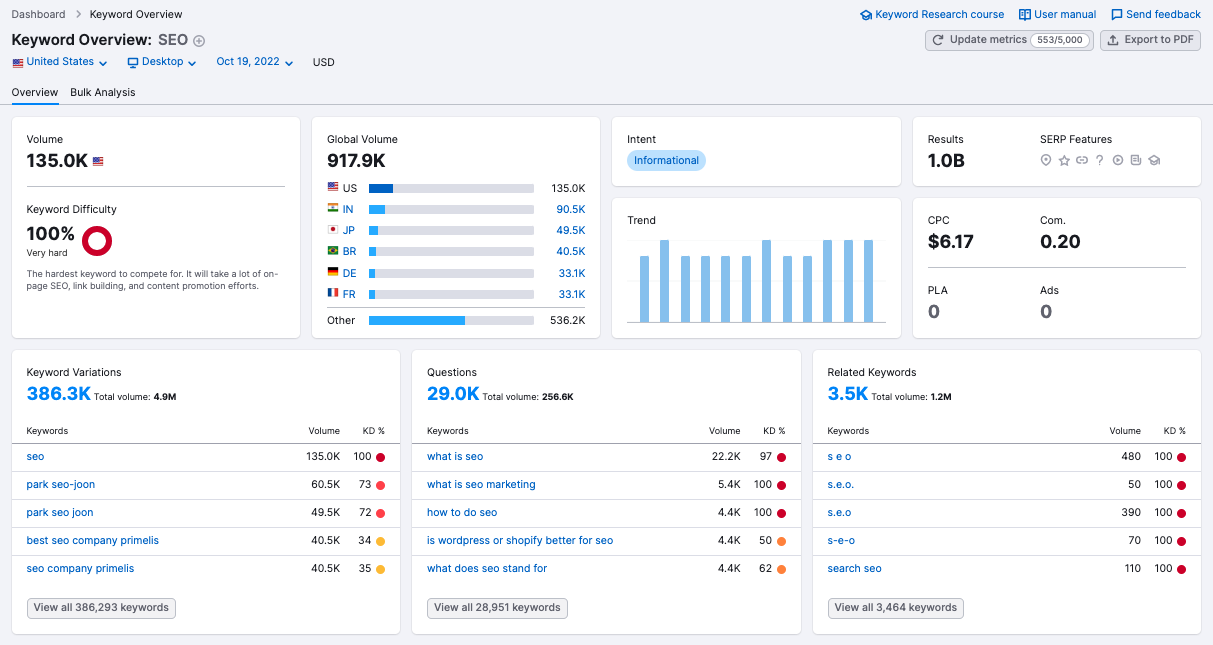
Here are a few things to look for and why:
- SERP features: These tell you what information or resources Google thinks users are really looking for in this search
- Intent: The motivation behind a search; includes informational (want to learn something), navigational (want to find something), commercial (researching a product or service), transactional (ready to purchase)
- Variations, questions, and related keywords: These tell you more about what users are looking for and how they’re trying to find it
By analyzing each of these elements, you can better understand how the search page is trying to help users right now. Later, you can use these findings to guide your content updates.
Next, analyze the most successful pages. The pages that are most successful post-update are likely the ones that most closely align with the goal of the update.
For this step, it’s a good idea to analyze several top-ranking pages in a single search. This way, you can identify patterns across the most successful results and apply your learnings to improve your own ranking.
You can find out which pages have fared well by using Keyword Overview. First, enter a keyword that was likely impacted by the update.
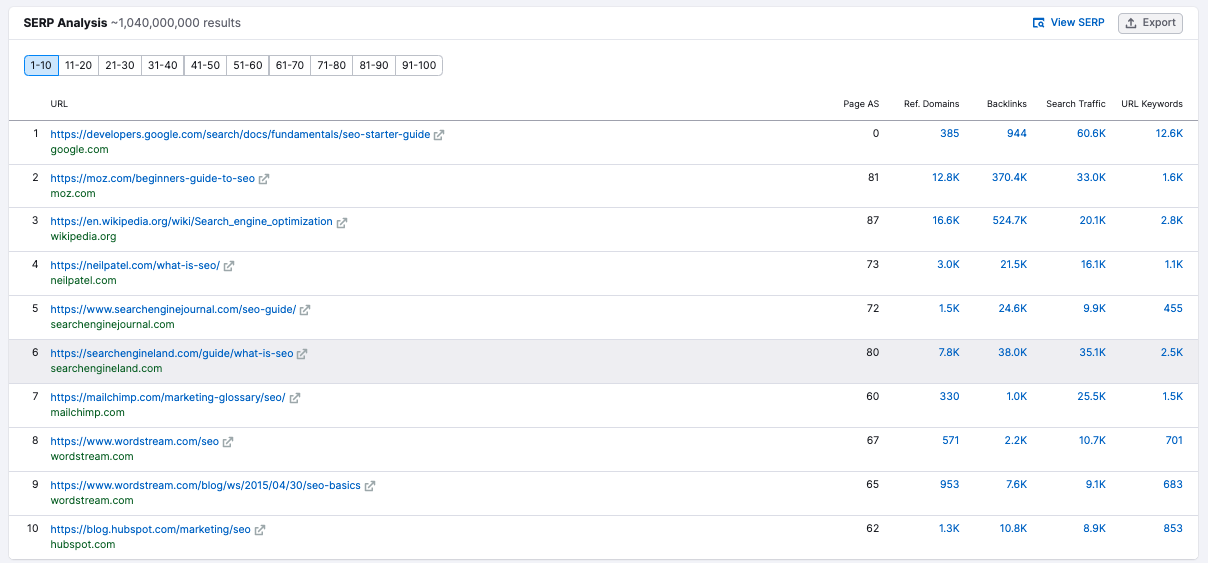
The SERP Analysis widget shows you not only who’s ranking, but also an overview of contributing factors: their Authority Score, backlink profile, search traffic, and number of keywords.
Click on any ranking page in this widget to analyze its overall performance in the Organic Research tool. Here, you can learn more about which keywords it has gained and lost, and how they’re each contributing to the page’s traffic.
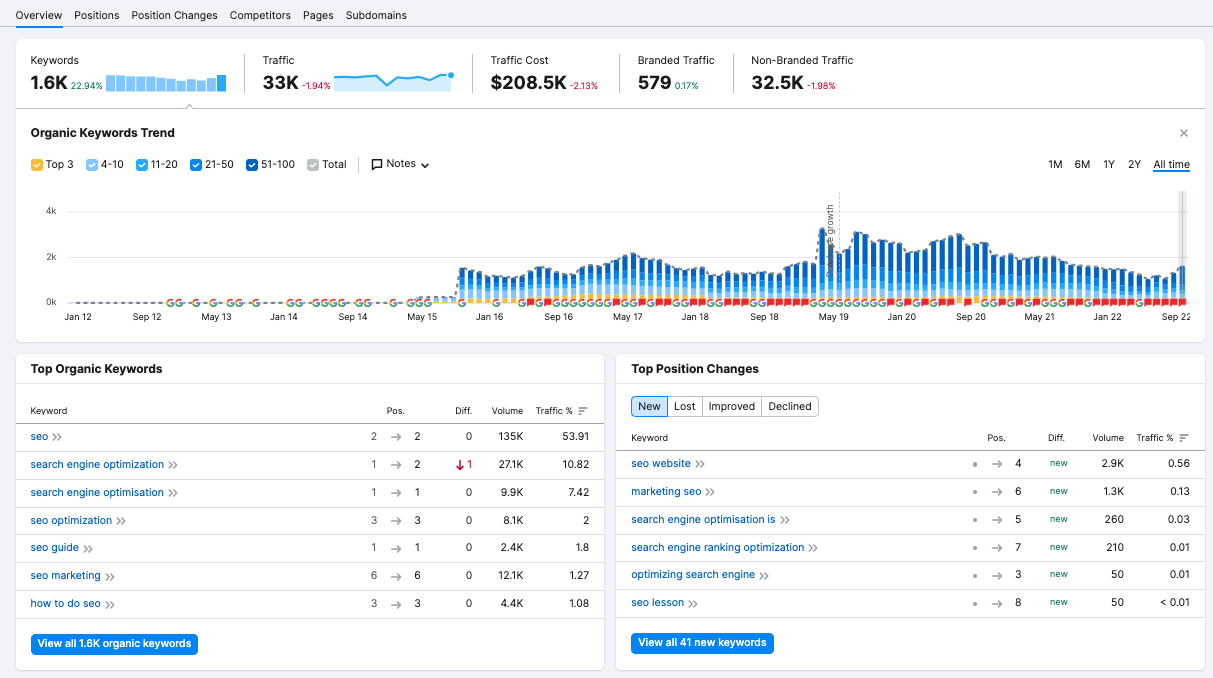
Finally, visit the page to analyze it yourself. Take note of the type of content, how it’s formatted, the navigation, and other important details. Do you notice any patterns between this and other ranking pages?
These insights can guide your analysis of your site’s content in the next question and inform your plan of action later.
Which Content on Your Site Was Affected?
Now that you know an update happened and what it was most likely about, the next step is to identify exactly which pages were affected. Specifically, you want to ask:
- Which pages declined?
- Did any pages improve after the update?
If you use Semrush’s Position Tracking tool, you can quickly identify affected pages using the Pages report.

Here, the Keywords count column can tell you which pages have won new keywords or that are no longer ranking for them. Meanwhile, Average position tells you whether a page has improved or declined.
First, note which pages have lost keywords or positions. Then, analyze those pages. Ask yourself:
- Which keywords have these pages declined on, and how well do they relate to the contents of the page?
- What do I already know about this update, and how does that relate to this page?
- What do these pages have in common?
- Regardless of ranking, how can I improve my user experience on each page?
Then, note which pages have improved by gaining new keywords or average position. Ask yourself:
- What makes these pages different from the ones that declined?
- Which keyword(s) has each page improved on?
- How are these pages different from the pages they’re now outranking?
In the next step, you’ll use all of these insights to build your action plan.
Step 2. Create a Plan of Action
So far, you’ve:
- Confirmed that there was an update
- Learned about the goals driving the update
- Analyzed your site to find out which pages need attention
So it’s time to dive in and start making updates, right?
Wrong!
It may be tempting to simply start at the top of the list and revamp your site page by page. But it’s probably not the best use of your time. Instead, take a deep breath and plan your next steps more strategically.
Gather Your Information
Start by reviewing what you already know:
- What update did Google make, and what was its goal?
- What is your site trying to do, and how does that align with the Google update?
- How was your site affected? Were there any patterns?
- Which specific pages declined due to the update?
This information will help you develop a strategy and prioritize the most effective updates.
How so?
Imagine that you run an educational blog that acts as a resource for other business owners in your community. Blog content is a big part of your strategy to attract new clients. You’ve got lots of short but helpful articles that answer specific questions.
Then, Google updates—and most of those pages plummet in the search rankings. So you do some research. You learn that its goal was to deliver more reliable in-depth content to searchers. When you check, you find that all of the winning articles share a few qualities:
- They’re at least twice as long as yours
- They use meaningful headers to provide structure and scannability
- They link out to high-quality resources
With these observations, you now have a few concrete changes you can make to help your content perform better.
Prioritize Your Work
Next, identify which pages are the most important to update. Focus your team’s efforts on:
- Pages that will make a bigger impact
- Easy wins
This will help you drive results more quickly. You can update lower-impact pages later on.
Determine which pages on your site are the biggest contributors to your goals. This could mean different things for different businesses. For example, you could focus on:
- Blog articles that receive the most organic traffic
- Landing pages with the highest conversion rates
- Content that supports your sales team
Once you’ve compiled this list, flag the pages that were negatively impacted by the recent Google update. These are your high-priority pages.
Next, identify your easy wins.
An easy win is an update you can make quickly, with relatively little effort, and still deliver positive results. For example, adding and updating headers in an existing article is an easy win because you can do it quickly. By comparison, doubling the length of an article is likely more difficult because it takes longer.
Learn about potential easy wins:
- In Google’s official recommendations about the update (if any)
- By analyzing winning content (yours or a competitor’s) and comparing it to your high-priority pages
- By paying attention to expert guidance (e.g., a Search Engine Journal article covering the update)
Finally, make a prioritization list to guide your update process. This is your action plan. It might look something like this:
- Make all easy-win updates to your high-priority pages
- Then, start working on more complex updates to high-priority pages
- Meanwhile, start making the rest of your easy-win updates to lower-priority pages
- Finally, start working on more complex updates to lower-priority pages
Use this plan to guide your team through the process of updating your site in step three.
Step 3. Strategically Update Your Site
By now, you have a clear picture of exactly what you need to do to help your site recover and how you want to approach that work. All that’s left is to make those updates!
Depending on how your site is set up, updates could be done in a snap, or they could involve a long and exhausting process.
Not sure which you are? Think about how you make regular content updates. Do you or your team:
A. Have easy access to the pages you need to update via a content management system?
B. Need to wait for a developer to make your changes on the back end?
C. Neither A nor B; it just depends on the page
If you picked B or C, the process of making your updates might be lengthy. In that case, set your team up for success by installing a tool like PageImprove, which enables you to edit any page on your site in real time without waiting for your development team to get around to it.
All you have to do is install the Google Chrome extension and insert a simple code snippet into the <head> tag of any page you want to be able to edit.
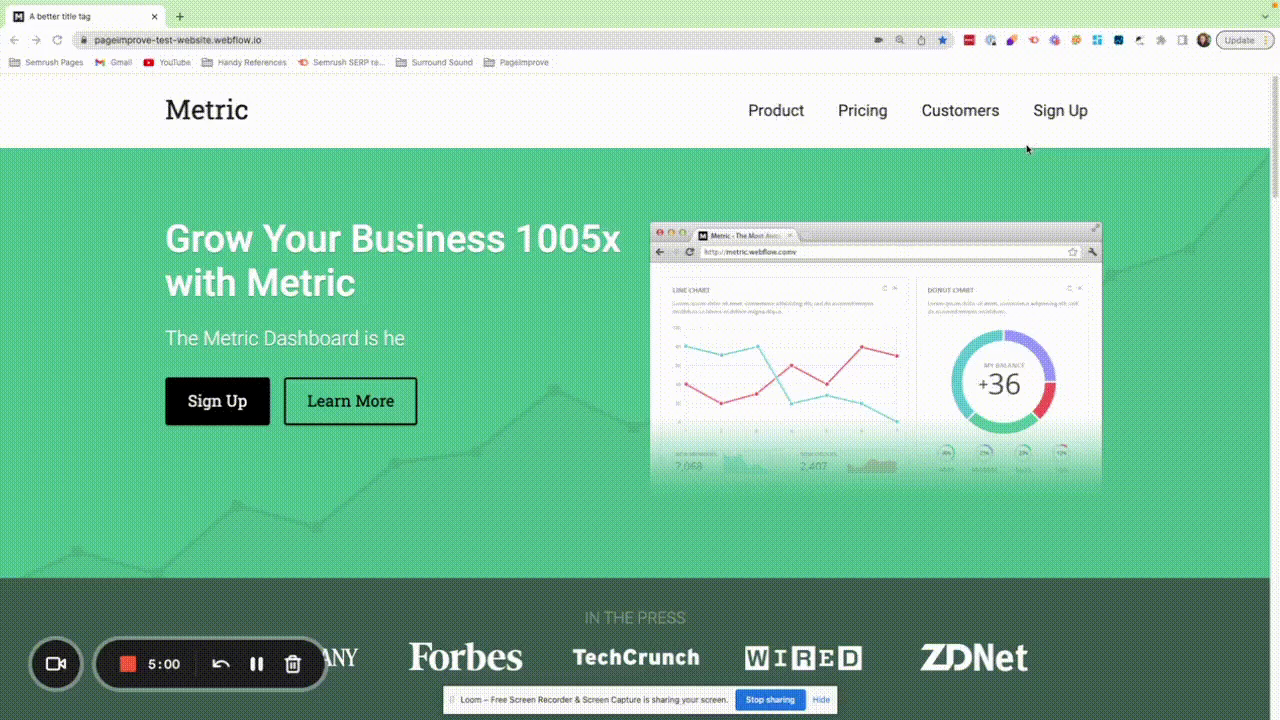
Use PageImprove to make all of your easy-win updates quickly and easily. For example, you could use the tool to update your meta tags, add alt text to your images, or update your headers.
With the simplest and most straightforward updates out of the way, you can start delivering results while your team works on the more complex content updates.
Set Your Site Up for Success
Google updates are a challenge that site owners are bound to face again and again. While it can be frustrating when it impacts your own site, try to look at each update as an opportunity to improve and provide better content for your audience.
With PageImprove, your site can respond to every update with agility, helping your site recover faster and perform better without any unnecessary delays.
Not convinced? Try it yourself today!
[ad_2]
Source link